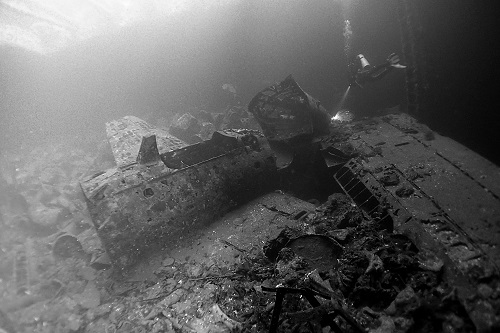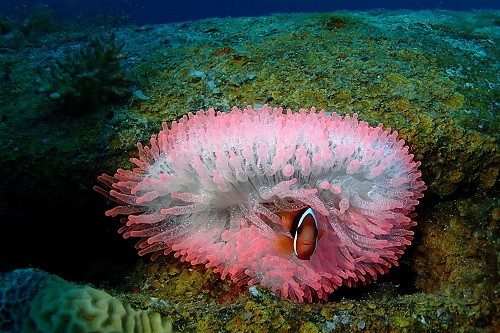The Fujikawa Maru is widely regarded as one of the best wreck dives in the world. We had fun looking through dozens of artifacts and delving deep inside the ship. Built in 1938, this cargo ship was requisitioned by the Japanese Navy for the war effort just two years later. The vessel and her crew survived two attacks earlier in the war. The Fujikawa Maru finally succumbed to multiple airstrikes when Operation Hailstone decimated the Japanese base at Chuuk Lagoon in February 1944.
Read more about the remains of the Japanese military operation on Weno island.
Bow Gun On The Fujikawa Maru
When we found this 6-inch gun on the bow, we had a close-up look at the maker's stamp. We were surprised to see the gun was forged in the UK in 1899. By the time the Fujikawa Maru was built, 40 years later, this weapon was already obsolete. Given that it wouldn't have been much use in combat, it was probably intended to boost the crew's morale.

Zero Fighter Aircraft
Inside cargo hold 2, we explored the remains of four Mitsubishi fighter planes. Three of these planes are A6M Zeros while the fourth is an older A5M Claude.

Telegraph On The Fujikawa Maru
This well-preserved telegraph on the bow was an essential part of the ship's communications system. We could still see the phrases 'Make Fast' and 'Let Go Anchor' despite the crusty layer of coral.

R2D2 And Where To Find Him
Probably the most recognisable relic in Chuuk Lagoon, this anthropomorphic air compressor has affectionately been nicknamed R2D2. Getting into the machine shop used to be a lengthy penetration but since the superstructure of the Fujikawa Maru collapsed, it has become much more straightforward. Diving down through the wreckage of the superstructure, we found a doorway that took us straight into the machine shop. Alas, R2D2 is at the far end, facing the wall so it took some time, and careful manoeuvring, to find him. Taking a suitable photo was even more tricky.

Drill Press
Inside the well-organised machine shop we also found a lathe, workbench and this drill press. The adjacent store rooms were packed full of fans, light bulbs and a host of other spare parts.

Chuuk Lagoon's Unexpected Neon Anemones
Nobody dives Chuuk Lagoon to see the marine life, it's just an added bonus. However, even the most avid rust hunters passed comment on the eye-catching neon anemones we saw on these wrecks. Even at depth, where everything else faded to grey, the vibrant pink, yellow or blue tentacles appeared just as bright.

Memorial Plaques On The Deck
There is a row of memorial plaques on the deck of the Fujikawa Maru. They commemorate both the lives lost during Operation Hailstone and the life of Kimiuo Aisek who pioneered diving in Chuuk Lagoon.

Diving The Fujikawa Maru
The Fujikawa Maru sits upright in 35 metres of water.
This is one of the best wrecks in Chuuk Lagoon so it will almost certainly be included in your diving itinerary. There's a lot to see so it's worth doing a few dives on it.
If you want to take it easy, there is plenty to see on the outside of the wreck and the cargo holds are quite open. However, there are some interesting penetrations too.
The superstructure collapsed in recent years and some parts of the wreck are quite unstable. Follow your guide's advice as they will know the current state of the wreck.
How To Get To Chuuk Lagoon
Flights to Chuuk are very limited and only operate around 3 times a week.
1. Fly to Tokyo, Osaka, Seoul or Manila.
2. Take a United Airlines flight to Guam and from there on to Chuuk.
Many thanks to the Odyssey liveaboard for their kind hospitality. The level of service on board was exceptional and the rooms were larger than the average hotel room. Captain Mike's in-depth knowledge of the wrecks and his detailed videos made the dive briefings really special too.
